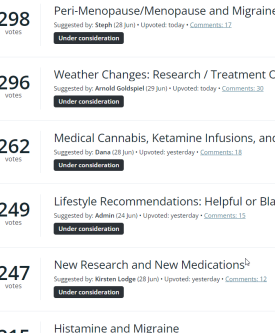Back in November, a look at recent articles about daith piercing as a migraine treatment resulted in a firestorm of comments and discussion. I have already responded briefly, but I would like to give an updated response in two ways this week.
First, because so many people are interested in this treatment, I would like to create a new post where we can update one another with the latest information about daith piercings and migraine.
But today, I want to respond to some of the criticism about the original article, and clarify a few things that might have gotten lost in the flurry of comments.
Before I do that, let me say again – if daith piercings help people, I will be the first one to cheer! Let’s just make that clear before we continue.
Some of the comments were beyond critical – they were very antagonistic. Incidentally, I think I’ve been approving almost all the comments. There was, admittedly, one exception – some accused me of being on a crusade because of religious reasons to stamp out piercings! Really?
Other criticisms included these:
- The author has obviously never had a migraine. Well, the author most certainly has – mind-numbing, cyclical vomiting, brain crushing migraine attacks. I realize this comment didn’t come in a vacuum, but I do think we need to be very cautious about diagnosing how much pain someone else has experienced. Many of us have had doctors who have brushed off our attacks as nothing to worry about – we need to think carefully before we do the same to each other.
- You want us to suffer / pay a fortune instead of trying an inexpensive possible solution! No, that wasn’t the point at all. I’ll talk more about this below, but I am not supporting “big pharma” and hoping to doom everyone to expensive treatments.
- “Until you’ve tried it yourself, this article is null and void.” With the hundreds of treatments out there, and because every migraine patient is so different, trying every treatment would obviously be impossible. I could make a list of things that worked for me, but that list would be one person’s opinion. The question is, does a given treatment tend to help people with migraine? How do we know? Are there stories? Is there a clinical trial? Where is the evidence?
- If it’s just placebo, why tell people? Why not let them have a little relief? Because if there’s something better they can try, why not start with that?
Listen, the point of the article was NOT that daith piercings do not work. The point was that, when the article was written, there was little or no evidence in the popular articles that were circulating. Other articles were being circulated claiming the benefits of daith piercing, but the evidence was not there. If you doubt it, go read the articles I linked to.
Now that the post has been up for a while, we have some people commenting and saying that the daith piercings have helped. That’s great! I’m sure we could get similar testimonials for other equally inexpensive and easy treatments. Now we need to start collecting the evidence more carefully. And I would love to see thousands helped as a result.
“I’m So Desperate, I’ll Try Anything!”
Now on to perhaps my biggest concern. First, I realize many of us have desperate moments – or weeks, or years – in which we would say,”I’m so desperate, I’ll try anything!” The pain and horror of migraine is why I’ve spend countless hours over many years in research and advocacy for migraine patients.
Now, let’s say we had a list of 25 treatments that you have never tried. They all were just as easy and inexpensive (let’s say). Now we put the list in order of evidence. The first 5 are well established, carefully studied, and have helped thousands. The next 5 have been carefully studied, and drastically help many, but others not so much. The next 5 are not well studied, but there is excellent, ongoing anecdotal evidence that they help people. The next 5 have a smattering of adherents, but no large following and no clinical trials. The last 5 – well, a few unsubstantiated stories, and that’s all. The trials seem to show that they’re of no help, or maybe even harmful.
Now, what if a TV ad came out, touting the benefits of one of the last 5 on the list? All of a sudden, everyone is talking about it. Your aunt tells you “You should try this!” Your boss says,”Why are you taking time off because of your migraine attack? I heard of this great new treatment…”
Which is better for you? To try one of the first 5 treatments, which is well-known and well-researched? Or to go with the latest TV ad?
Now we all fall into this trap sometimes – let’s face it. But why not start with the treatments that have the best chance of success, rather than the ones that happen to be on Facebook this week?
Here’s the sad truth that we need to face head-on. Many unscrupulous people hear us say we’ll “try anything”, and they prey on us and sell us products that are, indeed, “anything”. We waste our money – be it $5 or $500, on products that have no evidence behind them because they sound good and there are two pages of testimonials on the product website.
If there were only three treatments available for migraine, would I try all three? Sure. But there are probably more treatments than you can try in a lifetime.
If you read through the hundreds of articles I’ve written, I hope you’ll see that my desire is not to take away hope and support only expensive drugs (at times I’ve been quite critical of the expensive drugs!). My desire is to help you find the best way out of migraine, as soon as possible. And your emails tell me that many of you have been helped, and have found a way out.
Thank You.
That all being said, I would like to say “thank you” to those who commented – even those who were antagonistic. Although I obviously have some concerns, in most cases even these comments contained helpful thoughts. We need to be free to disagree, we need to be free to discuss the evidence. If we’re doomed to all think the same way, we’re never going to think outside the box enough to find real solutions to the age-old problem of migraine and headache.
Thank you also to those who left encouraging comments. We do tend to comment more when we disagree – so it was nice to see even partial agreement.
Thank you to those who offered constructive criticism, and links to more information, and personal experience. As regular readers know, I am always asking for that. These are the comments we’ll want more of.
Let’s keep working together to find treatments that work.
Now, since we are attracting many people who are interested in daith piercings, tomorrow I’ll set up a new post where we can continue to share information, so that you can see if this is something you would like to try.





